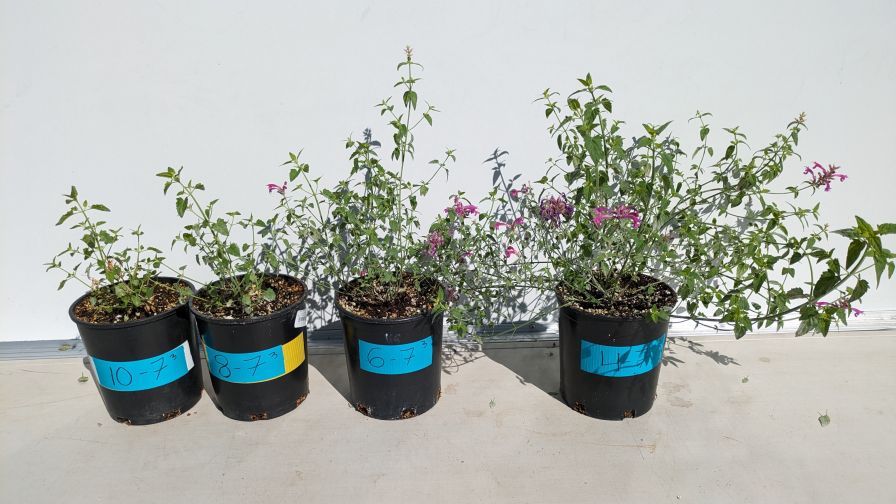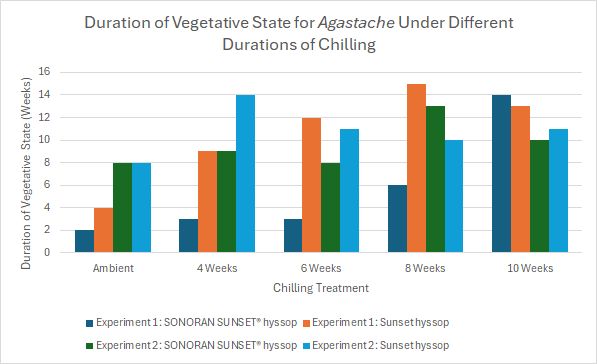
Sonoran sunset experiment plants | James Klett
Editor’s note: This is the second installment of a two-part series on Agastache chilling experiments from Colton Davis, Jim Klett, and Ronda Koski of Colorado State University. Find the first installment here.
Agastache is a genus in the Lamiaceae (mint) family. Known as giant hyssops, these perennials have beautiful foliage that produces a strong and sweet fragrance when brushed against. Agastache normally grows in mountains or deserts and is edible and can be used as an herb, in tea, or for medicinal purposes. There are about 22 different species of Agastache, and they are native to Asia (Russia, China, and other countries in Eastern Asia), and North America (western and eastern Canada, southwestern U.S., and Mexico).
In a previous article published in Greenhouse Grower, the authors discuss the cold tolerance of four different taxa of Agastache: A. rupestris (Sunset hyssop), A. cana ‘Sinning’ (Sonoran Sunset hyssop), A. aurantiaca ‘P012S’ (Coronado hyssop), and A. aurantiaca ‘Pstessene’ (Coronado Red hyssop). Coronado hyssop and Coronado Red hyssop had significant death caused by intolerance to cold temperatures. Due to this, Sunset hyssop and Sonoran Sunset hyssop will be the focal point of this article. Sunset hyssop and Sonoran Sunset hyssop are native to Arizona and New Mexico, and the flower colors range from sunset-orange and mauve to lavender-rose.
These Agastache are in the Plant Select program and are promoted for xeriscape landscaping. However, plant availability can be limited due to propagation problems related to the longevity of flowering. To improve the availability of vegetative cuttings, we researched growing Agastache stock plants under differing periods of chilling. It was found that increasing the chilling duration of Agastache results in a delay in reproductive growth. Two experiments were conducted over several months, and similar results were observed.

eight-week chilling treatment | James Klett
Two experiments were conducted between September 2023 and April 2024. Replicates of each species of Agastache were placed in a 35°F to 40°F cooler without light. A control set of replicates was kept in the greenhouse and the other sets were placed in the cooler for four, six, eight, or 10 weeks. The plugs used in the study were purchased from a local greenhouse (Gulley Greenhouse and Garden Center, Fort Collins, CO) and were transplanted into number one containers filled with Berger BM6 medium. The plugs for both experiments were acquired at the same time from the same seed source.
After transplanting, containers were placed on the greenhouse bench. Experiment 1 was transplanted on Aug. 18, 2023, and Experiment 2 was transplanted on Oct. 13, 2023. Experiment 1 was placed in the cooler on Sept. 29, 2023, and Experiment 2 was placed in the cooler on Nov. 10, 2023. All plants were cut back to a uniform height of 6 cm a week prior to being placed into the cooler and a Palladium fungicide drench was placed on all plants to help prevent stem and root diseases. After the plants had been in the cooler for their respective treatment time containers were taken out and placed on the greenhouse bench.
Initially, all Agastache were fertilized once a week, and as the plants grew, they were fertilized with each watering. Once all the Agastache in a treatment showed signs of reproductive development (buds and flowers), photos were taken, the date was recorded, and plants were discarded. Any replicate that died during the experiment was recorded with dates as well.
Experiment 1: Reproductive development occurred in the check treatment between two to four weeks after experiment initiation for Sunset hyssop and Sonoran Sunset hyssop. Reproductive delay occurred in all chilling treatments; this delay was determined from the difference in weeks between vegetative duration in the ambient treatment and the chilling treatments. Reproductive growth had the most delay in the eight- and 10-week chilling treatments. Sonoran Sunset hyssop delayed flowering four weeks for the eight-week treatment and 12 weeks for the 10-week treatment. Sunset hyssop was delayed in flowering by 11 weeks for the eight-week treatment and nine weeks for the 10-week treatment.
Experiment 2: Reproductive development occurred in the ambient treatment eight weeks after experiment initiation. Sonoran Sunset hyssop was delayed in flowering by five weeks for the eight-week treatment and seven weeks for the 10-week treatment. Sunset hyssop was delayed in flowering by three weeks for the eight-week treatment and four weeks for the 10-week treatment.
Many perennials go into a dormant state when subjected to cold temperatures. Agastache in our study did not produce any new growth while being placed in the chilling treatments. This study illustrates that the longer Agastache is in a dormant state, the longer it takes to produce buds.
This research can be helpful to growers to postpone flowering in some taxa of Agastache. Subjecting Sonoran Sunset hyssop and Sunset hyssop to chilling treatments of eight weeks can provide a delay in flowering of seven to nine weeks.

Duration of Vegetative State of Agastache Under Different Durations of Chilling | James Klett
Photoperiod was not constant for both experiments, which can have an impact on reproductive delay. Experiment 1 started with a photoperiod of 13 hours and ended with a photoperiod of 12.25 hours. Experiment 2 started with a photoperiod of 10 hours and ended with a photoperiod of 13.25 hours. Shorter photoperiods can cause a delay in reproductive growth in long-day plants. A separate photoperiod study was performed by the authors on a different long-day taxon that demonstrated the effect that different photoperiods have on reproductive development. 10-hour photoperiods produced no reproductive development, but 12-hour photoperiods had reproductive occurrence for that taxon. This may explain why the second experiment remained in a vegetative state longer than the first experiment in the ambient treatment. More research can be done comparing different weeks of chilling with different photoperiods to see which combination of chilling and photoperiod would have the greatest delay in reproductive growth for different taxa.
Chilling treatments of eight weeks on Sunset hyssop and Sonoran Sunset hyssop can provide seven to nine weeks of reproductive delay with photoperiods ranging from 10 to 12 hours; 10-week chilling treatments can provide up to 11 weeks of delay in flowering. The methods outlined in the study can be utilized in a production setting to allow for stock plants to stay in a vegetative state for a longer duration.

